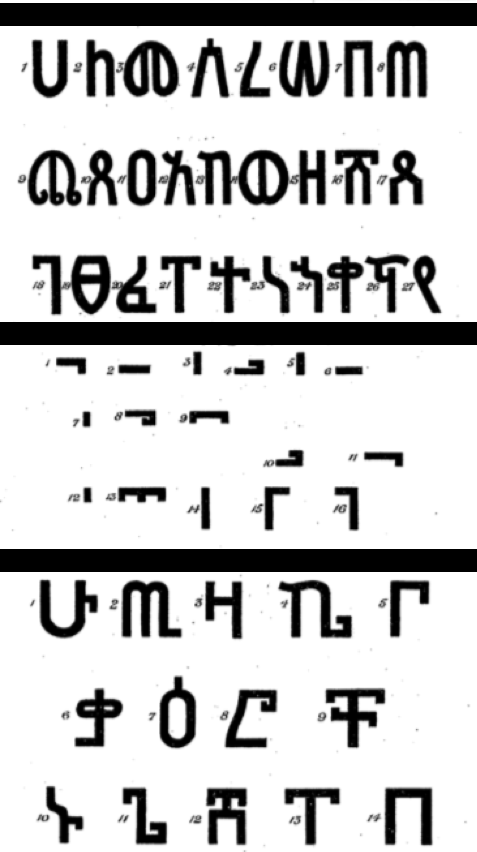CCT Alumni Highlight: Matt Lindia

CCT is excited to highlight Class of 2020 alum Matt Lindia in honor of his recently published article “Following Orders: A History of Amharic Typing” in the John Hopkins University Press’ Book History, Volume 25!
Lindia’s paper originated in Professor Meg Leta Jones’ Global History of Computers & the Internet class, which he then expanded upon and actually wrote during Archival Methods, another CCT class taught by Professor Jones. In Global History of Computers & the Internet, Professor Jones instructed her students to read a book the rest of the class wasn’t reading and present on it. He chose Thomas S. Mullaney’s The Chinese Typewriter and gave his class the history of the Chinese character symbol system and how it was initially difficult to adapt to keyboard technology. He explained the technical problems throughout the history of the Chinese typewriter and its insufficiency to account for characters in the Chinese language. He stated that many false attempts were made to construct an effective typewriter, but none were officially created. He also noted that this was a similar problem that Professor Osborn wrote about in his book Letters of Light , which is the book that drew Lindia to the CCT program in the first place and resulted in Professor Osborn advising his thesis. Professor Osborn’s book focused on the history of the Arabic language and how it encountered technical difficulties translating a cursive written language onto a technical keyword that was designed for Latin print alphabet writing systems. Lindia explained that both Letters of Light and The Chinese Typewriter sparked his interest and made him aware of the problem designing keyboards for non-Latin writing systems, so when he was tasked with doing an archival project in the Archival Methods class, he already had a starting point for a general subject area he wanted to cover.
In Archival Methods, his final class paper was the original template for this published article. For his final paper, Lindia had to complete a reverse engineer of a secondary source – essentially taking a secondary source someone else had done and seeing if he could apply that same kind of archival methodology to something he was interested in. He came across a Harvard online archive on Olivetti Diaspron 82, which was a typewriter for the Ethiopian Amharic language. Similar to Arabic, the Amharic language had a comparable problem being translated onto a typewriter as it is a syllabary language with a letter for every vowel/consonant combination. He explained in his paper that they still had different symbols for vowels, but would have base consonant and vowel modifiers, resulting in the language having 20 different consonants that each can be modified by eight vowels. This means that the Amharic language has about a few hundred characters, which is not as extensive as Chinese but is still hard to put on a keyboard.

This is one of the patents for the typeface that the Olivetti typewriter was ultimately based off of by Ayana Birrou. In the top section, you can see a selection of the completed characters. In the middle section you can see the vowel modifiers. In the bottom section you can see the consonant bases.
Lindia conducted further research and emailed the individual who donated the typewriter to Harvard, but she did not know it’s origins beyond her husband bringing it back from a trip to Ethiopia. He then discovered patents for Amharic typewriters, as well as articles on the development of the language and attempts at modernizing or westernizing it. One particular gem he found were Facebook posts by Aberra Molla, who designed a digital version of an Amharic typing system. This system was similar to the process used for typing Chinese characters into an iPhone, where users can type in base characters and vowel modifiers would pop up in a two-stroke system. This is an interesting, creative solution to a problem that takes advantage of digital technology (as a typewriter on paper is limited). Lindia found his articles and email and interviewed him. The fruit of that research ended up being his final paper for the Archival Methods class and allowed him to compile his story of developing digital keyboards with earlier typewriters and Amharic script form.
Lindia greatly enjoyed the process of writing on this topic, and it is the only published account of this history of the development of Amharic typewriters through script, printing press, typewriter, and digital technologies. He noted it is not often one stumbles across a black hole in the intellectual world and he was very excited to work in this area. He credits Professor Jones and how she designed her course to encourage a problem-solving mentality around the process of going into an archive and piecing together materials to find something no one had written about.
To get published, Lindia worked closely with Professor Jones who gave him constructive feedback on how best to improve and narrow down his paper. He then began the process of looking for journals to submit it to. Luckily, his focus was specific so he concentrated on finding people directly interested in that research area. He submitted to The Society for the History of Authorship, Reading and Publishing (SHARP flagship journal), which consisted of individuals interested in similar historical work. After submitting to the journal in early 2020, the revision and editing process was extended due to the pandemic and was published in fall 2022.
CCT is proud of Matt Lindia for his recent publication and looks forward to seeing what’s next for him in the future!
You can read Lindia’s full article at Johns Hopkins University Press.